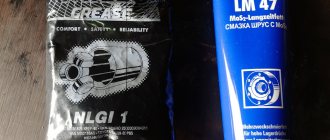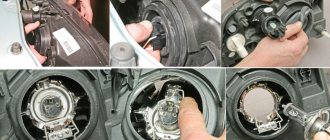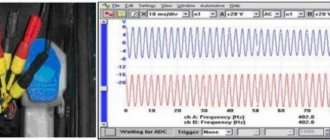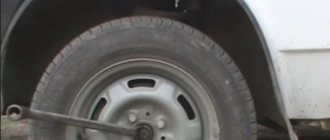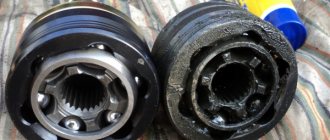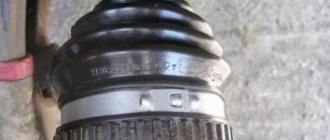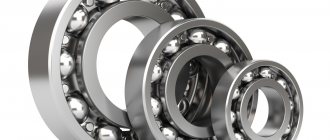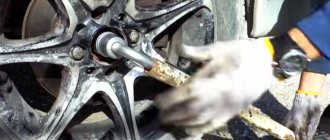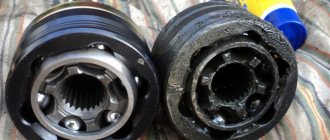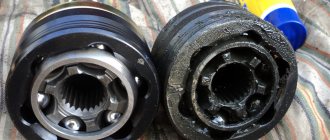Automotive manufacturing companies cannot do without the use of constant velocity joints. The proper functioning of these components determines the quality of functioning of a front-wheel drive vehicle. All mating parts that have a fairly high dynamic load are subject to high friction forces. Therefore, mandatory CV joint lubrication is required - these are plastic lithium compounds , which allow not only to maintain the hinges in good condition, but also to significantly extend their service life.
What is a CV joint, its functions and types?
CV joints are called constant velocity , which are used to ensure uninterrupted transmission of rotational motion from the gearbox and gearbox to the wheels at a constant speed. Their work occurs regardless of the angle of rotation, as well as the suspension or transmission. The design of these parts consists of external (fixed in the wheel hub) and internal (located in the transmission) hinges mounted on the axle shaft.
There are four types of CV joints:
- Ball CV joints are elements that transmit rotation using balls located in small grooves in body . They are mainly installed in front-wheel drive vehicles as an external wheel joint to provide high torque, as well as minimal play between the component elements. However, it must be taken into account that due to the special design of the ball CV joint, the axial movements of the suspension and transmission components are compensated not by it, but by other devices.
- Tripod elements are the most common type of CV joint that compensates for axial movements. A three-beam fork with rollers on needle bearings moving along guide grooves is fixed in the body of the structure. The tripod is used as internal wheel drive joints.
- Cam joints - these are usually installed in trucks. This is due to the fact that they have a low angular rotation speed, due to which the components are protected from overheating.
- Twin driveshafts are two connected joints used to compensate for uneven rotation of the balls. This type is installed in special equipment, as well as some models of trucks.
Regardless of the type of CV joint, the lubricant must be of good quality and changed in a timely manner. The appropriate product should be selected taking into account the type of components and technical characteristics of the vehicle in which they are used. Otherwise, used will be ineffective in reducing the friction force between parts.
Properties of lubricants for constant velocity joints
The composition of the CV joint lubricant is designed taking into account the difficult operating conditions of the joints, which makes it possible to provide reliable protection of the mechanism from the effects of various negative factors, as well as rapid wear. Due to their special properties, these products are used for the following purposes:
- increasing the friction coefficient of internal components;
- significant reduction in mechanical load on all components of the structure;
- slowing down the wear of individual hinge elements;
- increasing the protection of the surface of metal elements from corrosion destruction;
- ensuring a neutral reaction with different rubber hinge seals to protect the unit from damage;
- providing a water-repellent effect;
- extending the service life of the structure.
In this regard, a lubricant for external and internal hinges must have the following characteristics:
- Wide range of operating temperatures - from -40°C to +140°C and above, depending on the specific brand and article number . This property allows the composition to be used even in critical conditions without losing the effectiveness of protecting connections from loads.
- Increased degree of adhesion - the substance adheres well to the working surface of the device.
- High anti-scuff properties - due to this, an optimal level of sliding of the working surfaces is maintained.
- Physico-chemical, as well as mechanical stability of the product - these properties provide the same characteristics of the composition, regardless of the conditions of use.
To ensure safe and efficient operation of vehicles, CV joint lubricant must fully comply with the above requirements in terms of characteristics.
What challenges does lubrication face?
Any motorist knows that the lubricants used in machine components serve not only to reduce friction and prevent premature wear of metal components. It should also reduce the load on the parts, which will ensure their free rotation and allow the vehicle to move forward unhindered. If we talk about lubricants for CV joints, then, in addition to protection against friction, they also reduce fuel costs and transmission losses of the car.
The second most important property of a lubricant is to prevent the spread of corrosion. It is no secret that most failures of metal parts are the result of cavity corrosion, which is also called pitting or cracking corrosion. In this case, cavities called cavities form in the CV joints - in this case, the efficiency of torque transmission is lost and an unpleasant knock appears, which becomes clearly noticeable when turning the steering wheel. The lubricant is designed to prevent the spread of corrosion processes in CV joints in order to ensure their durability and protect the motorist from unnecessary costs.
In addition, lubricants must be gentle on organic and synthetic polymers. To protect the CV joint, rubber or plastic boots are always used, which prevent the entry of pollutants from the outside. The lubricant should not dissolve the material from which they are made.
Types of lubricants for CV joints
Manufacturers offer several types of CV joint grease. They differ not only in composition, but also in other parameters - operating features, efficiency, shelf life.
There are several popular types of lubricant:
- lithium;
- barium;
- products with molybdenum;
- on a polyurea basis.
The properties of these funds are discussed in detail below, the study of which will allow you to choose the most suitable option for a particular case.
Lithium CV joint greases
CV joint greases, which are made on the basis of lithium soap and thickeners, have a shade from pale yellow to light brown. It is better to lubricate CV joints with them, which will be operated at medium or high temperatures, because in other cases the substance quickly loses viscosity and does not provide adequate protection of the ball structure in cars with front-wheel drive .
CV joint grease with molybdenum
Molybdenum grease for CV joints is practically no different in properties from lithium products. However, due to the addition of molybdenum disulfide to the composition, the substance provides reliable anti-corrosion protection of metal surfaces.
When using this composition, it must be taken into account that if even a small amount of liquid gets on the boot, the joint lubricant quickly turns into an abrasive . Because of this, damage appears on the inner surface of the constant velocity joints. To avoid problems, it is necessary to regularly check the tightness of the case, as well as the condition of the anthers.
Barium lubricants
Barium grease is the most technologically advanced and effective method of maintaining CV joints in good condition. Such products have increased chemical resistance, as well as improved performance properties. In addition, these substances do not interact with moisture and polymers, therefore they are suitable for both internal and external CV joints. However, they should not be used at low temperatures, so as not to lose their quality.
Polyurea-based CV joint lubricant
Recently, polyurea-based products have often been chosen to lubricate pomegranates. They contain a synthetic polyurea ashless thickener. They are more plastic and differ significantly from traditional soap thickener substances.
There are several characteristic features:
- Excellent anti-oxidation properties prevent aging of the lubricant when operating at sufficiently high or low temperatures. Therefore, it is often used as a lifelong lubrication of constant velocity joints.
- The substance does not coke at a significant increase in the temperature of the working environment. In addition, no ash deposits are formed during operation, so no special maintenance of the structure is required.
- MS CV joint lubricant, thickened with polyurea, is characterized by increased water resistance - this property allows the device to be operated not only at high humidity, but also under conditions of dynamic exposure to liquid.
- Increased resistance to chemically active environments (alkali or acid).
Which lubricant for CV joints is better at low temperatures?
CV joint lubrication must work in different conditions, including temperatures down to -50°C. The most suitable brands for use in the cold season are the CV joints MS X5, CV joints-4, RAVENOL Mehrzweckfett mit MoS-2.
What lubricants should not be used for CV joints?
For lubrication, you cannot use any CV joint or lithol. It is necessary to familiarize yourself with the composition and determine whether the product will work under certain conditions. In particular, it is prohibited to lubricate CV joints with the following substances:
- graphite lubricant;
- "Grease 158";
- technical petroleum jelly;
- oils containing hydrocarbon compounds;
- substances containing calcium or sodium;
- various compositions based on zinc or iron.
Graphite lubricant, like the other listed substances, not only does not provide adequate protection of the boot and other elements from wear, but also reduces the quality of the vehicle.
Which lubricant should not be used?
Very often, car owners become victims of the marketing moves of car product sellers - they claim that their products will guarantee the reliability and safety of the vehicle, although in reality the situation is completely opposite. For example, graphite lubricant should not be used to protect CV joints, since it is intended to protect bearings and other moving joints of electric motors. Before purchasing graphite lubricant, you should understand that the service life of CV joints with it will be no more than 20–25 thousand kilometers. You should be especially careful when ordering a lubricant change from a garage service - they often use low-quality materials or materials that do not meet all requirements.
In addition, you should not purchase hydrocarbon products, including technical petroleum jelly, despite the fact that their packaging may contain information about the possibility of processing CV joints. The reason for this is the preservative nature of hydrocarbon compounds. They perfectly withstand exposure to moisture, do not allow corrosion and damage by foreign contaminants, but begin to deteriorate after reaching a temperature of 45 degrees. It is clear that in such highly loaded transmission components as CV joints, the temperature will be much higher, which will lead to complete washout of the lubricant after just a few kilometers. The use of technical petroleum jelly and other hydrocarbon products to protect CV joints can only lead to their failure after a very short period of time.
Consistent compositions based on sodium or calcium can also contribute to the rapid destruction of the CV joint. They are used in the assembly of various vehicle components, including bearings, moving joints, and drive cables, but are completely unsuitable for working in highly loaded components, an example of which is the CV joints of a front-wheel drive vehicle. The worst consequence of their use may be the accelerated spread of corrosion - the result will not take long to arrive and after 15–30 thousand kilometers the CV joints will become completely unsuitable for further use. Among the lubricants containing mineral components and prohibited for use in car transmissions, one can also name compounds based on iron and zinc.
Replacing lubricant in CV joints
Changing the CV joint grease is quite simple, so you can do the job yourself. To do this, follow the step-by-step instructions:
- First, you need to remove the CV joint - the sequence of removing the device depends on the design features of the vehicle, so there is no single algorithm of actions.
- Disassembling joint tube - you need to carefully remove the two retaining rings using a screwdriver.
- Dismantling the boot and sealing ring, as well as checking them for various damages - if any are found, they should be replaced.
- Removing all internal parts and then disassembling.
- Washing the elements in gasoline or solvent - carefully remove any remaining old lubricant.
- About 90 g of lubricant is placed in the glass - to fill the substance into the container gradually.
- Installing the tripod in its original place.
- At the end, you need to add the missing amount of lubricant to the CV joint - you will need approximately 120-150 g of the substance. To fill the glass tightly, you need to gradually move the tripod axis in the process.
- The assembly of the structure is carried out in the reverse order to dismantling. In this case, it is necessary to check that the axis of symmetry of the separator should be perpendicular to the body. Finally, you need to lubricate the grooves and then tighten all the clamps or rings tightly.
All components must be well lubricated, so the amount of substance must be calculated correctly.
How often do you change the lubricant?
The lubricant for the grenade should be changed every 80-100 thousand km. However, it must be taken into account that if the vehicle is used in rather harsh conditions, it is better to replace it after a run of 50-60 thousand km.
Main characteristics of the lubricant
Based on the tasks of lubrication for tripods and other types of CV joints, the characteristics that such a substance should have include:
- wide temperature range. Thanks to this, the unit will operate normally in any temperature conditions. It is also worth remembering that inside the node the temperature reaches 100 degrees Celsius or more;
- high level of adhesion (assumes good adhesion to the surface). To put it simply, the lubricant should be sticky and stick to the surface of the assembly;
- high anti-scuff properties. As a result, the substance will be able to ensure normal sliding of the element over a long period;
- mechanical and physico-chemical stability of the composition. It is important that the lubricant maintains its effectiveness, regardless of the external environment.
Below is a video about choosing a lubricant for a CV joint:
Application of lubricants for CV joints
To use lubricant for ball CV joints, it is necessary to select a product of a suitable brand, based on the type and characteristics of the component elements.
Suitable for lubrication of the inner CV joint:
- Slipkote Polyurea CV Joint Grease;
- Mobil SHC Polyrex 005;
- VAG G052186A3;
- Mobile Mobilegris XHP 222;
- BP Energrease LS-EP2.
Any of these products can be applied without removing parts from the structure.
For external lubrication in CV joints, the following brands can be used:
- Mobil Mobilgrease special NLGI 2;
- Liqui Moly LM 47 Langzeitfett + MoS2;
- Chevron SRI Grease NLGI 2;
- XADO CV joint;
- lubricant "CV joint-4".
Barium
Recently, such CV joint lubricant has been in increasing demand on the market. The progressive composition allows you to extend the service life of the hinge, as well as protect it from a number of negative influences. The main advantage here is that the substance is not at all afraid of moisture.
Thus, if the boot ruptures, there is no need to change the substance. In addition, the lubricant has excellent corrosion resistance and is also suitable for use even in fairly aggressive conditions. The composition is chemically neutral, so the anthers will not be damaged, regardless of the material of the seals.
The main disadvantage of such a substance is its relatively high price, which is caused by the complexity of the production process. We produce only ShRB-4 lubricant; everything else has to be purchased in other countries.
The best lubricant for CV joints
When purchasing this product, you can be guided reviews , recommendations from equipment service specialists and vehicle manufacturers.
The rating of CV joint lubricants includes five popular products:
- CV joints-4 are Russian-made products that are used to lubricate ball bearings of external joints, parts in telescopic struts, and carburetors. It is made on the basis of lithium hydroxystearate and is suitable for use at temperatures from -40°C to +120°C.
- SHRUS-MS VMPAUTO lubricant is a black Vaseline-like composition of domestic production, which in terms of consistency belongs to class ⅔ according to the NLGI system. Its penetration range is 265-295 for class 2 and 220-250 for class 3. The substance is typically used to treat bearings to reduce friction within them. It should be noted that its consistency is maintained even after the anther is damaged.
- Liqui Moly LM 47 Langzeitfett + MoS2 is a German lubricant that is made in the form of a plastic liquid with a fairly thick consistency. This substance has a dark, almost black color. A lithium complex is used as a thickener, in addition to which the composition contains various additives, mineral base oil, as well as solid particles to reduce the friction force between elements. This product is excellent for servicing external CV joints, which are operated at temperatures from -30°C to +125°C.
- RAVENOL Mehrzweckfett mit MoS-2 is a substance that is produced in Germany with the addition of molybdenum disulfide. It is resistant to salt water, and also perfectly retains its performance properties over a wide temperature range - from 30°C to +120°C.
- XADO for CV joints is a Ukrainian lubricant from the budget category, which is intended for processing external joints. It has a light amber tint and contains a special revitalizant that slows down deformation and wear of component parts.
- STEP UP is an American lithium grease that can be used for internal and external CV joints. This is a high-temperature substance that operates at temperatures up to +250°C. Its distinctive feature is the presence of a lithium complex, a special conditioner SMT2, and molybdenum disulfide.
lubricated with a high-quality composition are a mandatory requirement for vehicle operation, especially in aggressive conditions. When choosing a lubricant, it is necessary to take into account the design features of constant velocity joints, as well as the conditions of use of the vehicle. You can choose a suitable product and perform the replacement yourself or with the help of a specialist.
Use of lubricants at low temperatures
Many car owners living in the northern regions of our country are interested in the question of choosing CV joint lubricants that would not freeze in severe frosts (for example, -50°C...-40°C). The decision must be made based on the information provided by the manufacturer. This is very important, not only for lubrication of CV joints, but also for other oils and fluids used in cars in the north.
According to reviews from car owners living in the far north or close to them, domestic lubricants “CV joint-4” and RAVENOL Mehrzweckfett mit MoS-2 . However, we will touch on the choice of lubricants a little later.
Secrets of CV joint maintenance: Don’t let the “grenade” explode
What determines the resource of CV joints and simple secrets of their maintenance.
What does the resource of CV joints depend on and simple secrets of their maintenance?
The service life of constant velocity joints (CV joints) depends on many factors. This indicator is most significantly influenced by design features, manufacturing technology, operating conditions and modes. If the first two circumstances do not depend on the car owner, then the other two are completely in his hands.
Who is last?
Natural wear of the hinge is natural and inevitable. However, very often the resource of these components is reduced due to the fault of car owners. Some, for example, like starts with slipping with the wheels turned out. The outer hinges in this position are partially clamped, and therefore experience excessive loads, which can even lead to the complete destruction of this expensive unit.
Others - tuning enthusiasts - seriously boost the engine, which also contributes to overloading the CV joints. The more torque in relation to the nominal one has to be transmitted to the hinge, the more intensively it wears out.
Still others forget to monitor the condition of the corrugated boots of the CV joints. But in most cases, the service life of this important part is reduced precisely because of the rupture of the boot. Its tightness is the main condition that determines the durability of the hinge during operation. A cracked or torn cover is not able to protect the “grenade” from water, dust and sand. As a result, lubrication is lost, corrosion of the working surfaces begins, and grains of sand trapped inside act as an abrasive, causing accelerated wear of CV joint parts - balls, cages and knuckles. Increasing gaps over time inevitably causes knocking or crunching noises. Alas, these parts cannot be repaired - only replacing the unit will help get rid of the unpleasant sound, and this is not a cheap pleasure: an external hinge for foreign cars usually costs 250 - 500 hryvnia.
How often to change the lubricant
As a rule, replacement is required after 50-60 thousand kilometers, but here you need to read the instructions - for some manufacturers the lubricant service life can reach as much as 100 thousand km.
In addition, if the vehicle has not been used for 9 months, or has been rarely used for 18 months, then it is also recommended to replace the substance. At the same time, in some cases the composition must be replaced prematurely, so it is worth checking the condition of the lubricant sometimes.
We strongly recommend that you regularly change the CV joint lubricant, following the instructions and rules established by the vehicle manufacturer. Remember that the cost of such a procedure will be an order of magnitude lower than repairing or replacing the hinge itself. As for the choice of substance, the modern market offers a fairly large assortment of lubricants. There is no need to save money and buy the cheapest substances. It is better to trust trusted manufacturers. Moreover, the difference in price will be relatively small.
Next is a video about the best lubricant for CV joints:
How to add lubricant to CV joints 2109 without removing the files?
Truck injection syringe
I think it’s much easier to remove than this way. to be. don't agree?
I'll have to take it off one side and add it! but it’s not like that.
If the question is asked like this, then there is no need to add anything - replacing the grenade (from the factory, lubricant is applied for the entire service life of the CV joint - and if it crunches, then just replace it)
If you can't get inside, spread some grease on top and tie the dog to the wheel. The grease will get scared and crawl into the boot itself.
If it becomes necessary to forget the grease and remove the old one, it is only because of a torn bushing, why change the boot and replace the grease.
